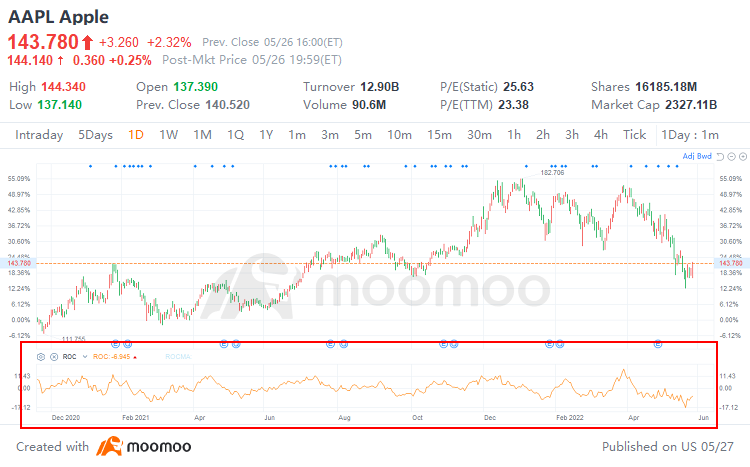What is the rate of change indicator?
Key points
The rate of change (ROC) is a momentum index to measure the speed of change in securities prices.
Generally speaking, the positive and negative sign of ROC indicates whether the price is rising or falling, and the moving trend of ROC indicates the trend of price change.
Signals such as overbought and oversold and deviating from the trend can be identified by ROC.
Understand the rate of change index
The rate of price change is a momentum indicator, which measures the rate of price change between the current closing price and the closing price before a certain period of time.

Its formula can be expressed as follows:
ROC= (day's closing price -n* Day's closing price) /n* day's closing price
For example, if Apple Inc's closing price is $143.11 on May 23, 2022 and $156.54 on May 5, 2022, then the 12-day ROC is-8.579, and the formula is [(143.11-156.54) / 156.54] * 100.
How to apply the rate of change Index
Trend recognition
As a momentum-based price indicator, ROC measures the trend and intensity of price changes.
Generally speaking, as long as the ROC remains positive, it means that the price is going up. Conversely, when ROC is negative, it indicates a decline in price. There is no upper limit, but there is a lower limit for ROC, because the price can only be reduced by 100% at most. In addition, the rise of ROC above zero indicates that the upward trend is accelerating, while the decline of ROC above zero indicates that the upward trend is slowing down.
ROC crossing the zero line in either direction may indicate a change in trend. However, ROC sometimes hovers near the zero line. Therefore, the main purpose of ROC is to warn traders of possible price trends, rather than to provide an accurate trading signal.
Identify overbought or oversold signals
ROC can be used to identify extreme situations and predict turning points. When ROC rises to a relatively high level, it indicates that the stock is overbought, which is usually seen as a sell signal.

In contrast, when ROC falls to a relatively low level, indicating that the stock is oversold, it is usually seen as a buy signal.

Deviation signal recognition
ROC is also widely used to identify deviation signals and predict trends that may be about to occur. In most cases, ROC moves in a similar direction to stock prices. However, if the ROC curve shows a downward trend, but the stock price has a new peak, there will be a deviation, indicating that the stock price may not be able to maintain its upward trend in the future. For example, the situation in the following figure.

To sum up, ROC has effective applications in many aspects, but it also has some disadvantages. For example, for ROC deviation, it sometimes gives the wrong signal. When ROC starts to deviate, prices can still run in the trend direction for some time. Therefore, traders should not only use ROC as a technical index as a basis for judgment, but also look at other indicators and analysis methods in order to more accurately judge the trend of price changes.
